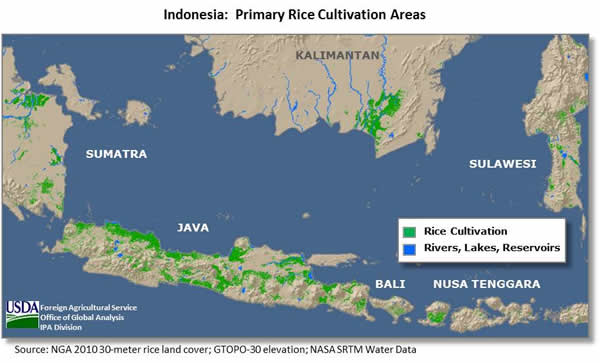INDONESIA: Rice Production Prospects Reduced by El Nino
A strong El Niño weather pattern has suppressed rainfall over a wide swath of southeastern Asia during 2015 and early 2016, and is currently affecting the Indonesian archipelago. Rainfall in Indonesia’s prime rice growing areas on the islands of Java, Sumatra, Sulawesi, and Kalimantan has been erratic and deficient, forcing farmers to delay planting well beyond the optimal period during the wet season which traditionally runs from October through April. Planting typically begins with the onset of rains in October and is completed by late November. This year, many farmers had to delay rice planting into late January and early February. The wet season is the most important rice growing period of the year, supporting both irrigated and rainfed grain farming. Rainfed rice area and production in particular are at their peak during this season, with more than a million subsistence farm families dependent on the rainfed crop for their livelihoods.

Low rainfall (less than 75 percent of normal) has been widespread this year, affecting rainfed rice prospects in both upland and lowland growing zones on all of the main islands. Moisture deficiencies have resulted in persistent mild to moderate drought conditions and drought and erratic rainfall are expected to cause modest declines in the overall crop area for rainfed rice during the current USDA 2015/16 marketing year (October 2015 through September 2016). USDA now estimates total rice area at 11.7 million hectares, down 0.5 million from last month, down 1.0 percent from last year. Yield is forecast at an above-average 4.77 tons per hectare, up approximately 1 percent from last year. The higher yield is attributed to the loss of lower-yielding rainfed rice acreage, resulting in a higher proportion of the national crop coming from primarily irrigated lands. Total 2015/16 rice production in Indonesia is now forecast at 35.3 million tons, down 1.0 million metric tons from last month, down 1.0 percent from last year.

Seasonal Rice Cultivation
Rice is cultivated in both lowland and upland elevations throughout Indonesia, with the upland crop typically being rainfed and receving only low levels of fertilizer applications. Irrigated lowland rice is both well watered and heavily fertilized - accounting for approximately 80 percent of total national rice area and 93  percent of total production. As a result, irrigated lowland rice yields on average are about 60 percent higher than rainfed upland crop yields. Lowland rice cultivation is heavily concentrated on Java, but is also prevalent on Sumatra and Sulawesi - the 3 islands together contributing about 89 percent of total national rice production. A small amount of rice grown on the outer islands under a traditional shifting cultivation system using slash and burn techniques. This crop is usually associated with small farmers in remote areas who are establishing a mixed plantation of rubber trees and food crops. percent of total production. As a result, irrigated lowland rice yields on average are about 60 percent higher than rainfed upland crop yields. Lowland rice cultivation is heavily concentrated on Java, but is also prevalent on Sumatra and Sulawesi - the 3 islands together contributing about 89 percent of total national rice production. A small amount of rice grown on the outer islands under a traditional shifting cultivation system using slash and burn techniques. This crop is usually associated with small farmers in remote areas who are establishing a mixed plantation of rubber trees and food crops.
There are typically three rice growing periods or seasons in Indonesia, a single wet season crop followed by two dry season crops. Approximately 45 percent of total production is usually from the wet season crop, cultivated from October to December and harvested from March through April. Both rainfed and irrigated crops are grown in the wet season, with rainfed crops accounting for approximately 15 percent of total area and 12 percent of total production. Wet-season rainfed rice is cultivated on an average of 1.0 million hectares and yields roughly 2.0 million metric tons of production (milled basis). Ample stored irrigation reserves in upland reservoirs allow Indonesia to cultivate two additional rice crops during the long dry season when precipitation is typically too low to grow rainfed rice. These crops are usually 98 to 99 percent totally irrigated, with rainfed rice only being grown in small isolated areas where moisture permits. Rainfed rice in the dry season is a very risky endevor, with crop failure or abandonment common.

Owing to generally low rainfall and moderate drought in many of Indonesia’s primary rice growing areas, rainfed rice area is expected to decline during the 2015/16 wet season relative to both last year and the 5-year average. In addition, delayed planting of this year’s wet season rice crop will cause ripple effects through the next two growing periods during the dry season owing to its late maturation and harvest. Therefore, it is unlikely that rainfed rice will be cultivated for the remainder of the year. In total, USDA forecasts rainfed rice area in Indonesia will decline approximately 500,000 hectares this year, while milled production will fall 1.0 million metric tons.
This report has been published by the Office of Global Analysis (OGA), International Production Assessment Division (IPAD). Current USDA area and production estimates for grains and other agricultural commodities are available on IPAD's Agricultural Production page or at PSD Online.
Related Links at FAS
Indonesia: Stagnating Rice Production Ensures Continued Need for Imports
http://www.pecad.fas.usda.gov/highlights/2012/03/Indonesia_rice_Mar2012/
Visit Crop Explorer http://www.pecad.fas.usda.gov/cropexplorer/
|

